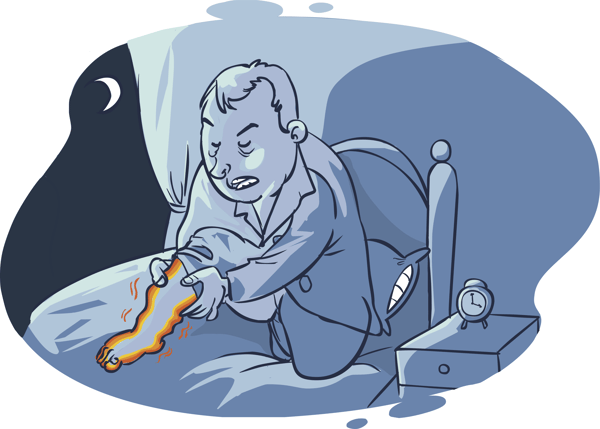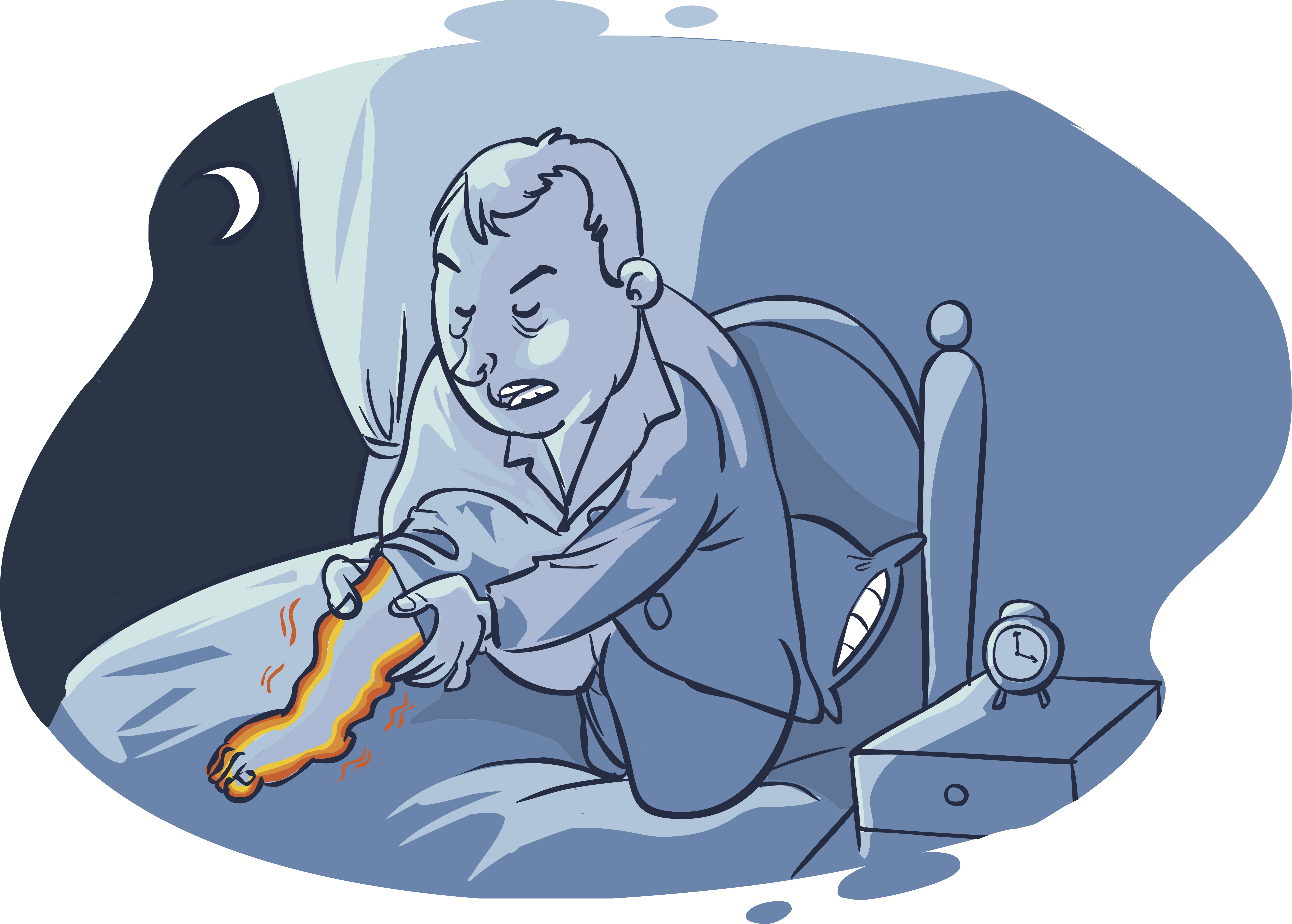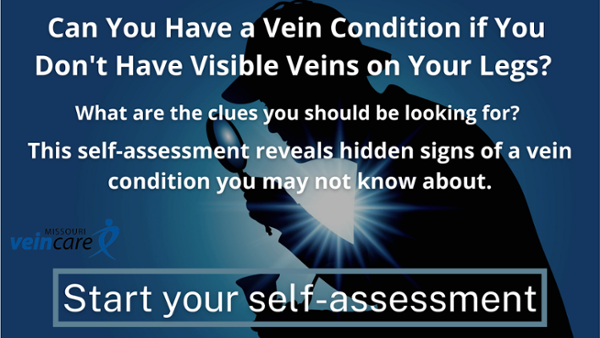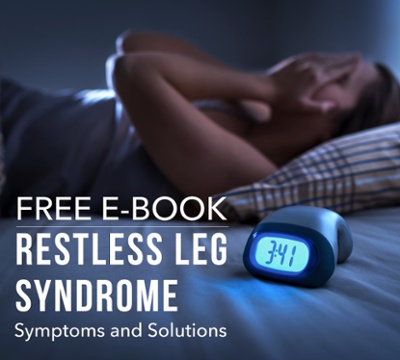Frequently Asked Questions About Restless Legs Syndrome

Restless Legs Syndrome (RLS) is one of the most frustrating conditions you can experience. Also known as Willis-Ekbom Disease, it is often described as the inability to cease moving your legs or an uncontrollable urge to move your legs. It is described as a tingly, crawly, buzzing sensation throughout the legs or even a sensation of electricity zinging through your body, and it always occurs when you rest during the day or more commonly during the evening.
One of the criteria for the diagnosis is that the sensation and experience of restlessness go away when you get up to move. People naturally learn that this is the key to getting relief, and for the majority who experience this in the evening, this means getting up and walking around. As a result, RLS often disrupts sleep patterns by making it difficult if not impossible to fall asleep. In many cases, sufferers can also be awakened from sleep with the need to move their legs.
The sleep interruption due to the condition usually results in substantial fatigue the next day. When the condition gets severe enough, sufferers will eventually choose to avoid evening events such as watching movies, shows, travel, or sporting events that could trigger RLS symptoms. Read on to learn more about RLS and what can be done to treat this often life-disrupting condition:
What Are Possible Causes of Restless Legs Syndrome?
Although the exact cause of RLS is unknown, there are known factors that contribute to the presence of the disease. For example, when RLS is present, sufferers often also have one or more of the following conditions:
- Renal disease.

- Iron deficiency.
- Nicotine, alcohol, or caffeine use.
- Neuropathy.
- Pregnancy.
- Underlying vein condition.
- Sleep issues are perpetuated by the condition, meaning the condition causes sleeplessness, which then seems to make the condition worse. For those with this diagnosis, some actually have an undiagnosed vein reflux condition that will respond to treatments.
How is Restless Legs Syndrome Diagnosed?
There is no RLS test that will unequivocally say you have or don’t have RLS. However, healthcare providers consider the five basic criteria listed below as necessary to make the diagnosis:
- You have an overwhelming, powerful urge to move your legs, which is accompanied by uncomfortable, unpleasant, and abnormal sensations in the legs.
- You notice the urge to move your legs intensifies when you are inactive, such as when you are sitting still or resting.
- You can relieve the unpleasant sensations at least partially or temporarily by moving. In fact, moving can totally relieve the symptoms, but only temporarily.
- The urge to move your legs and the uncomfortable sensations are most noticeable or exaggerated in the evening hours or at night.
- The aforementioned criteria are not caused by any other known behavioral or medical condition.
What Are Treatments for Restless Legs Syndrome?
The following are some common actions that have been known to offer some relief to the symptoms of RLS:
Lifestyle Changes
This could mean avoiding nicotine, alcohol, or caffeine. Remember, caffeine remains in your system for hours after consumption, depending on how much you drink earlier in the day. That means even a morning mug of coffee could affect your ability to fall asleep later that same night.
Take Iron Supplements
Since iron deficiency correlates with RLS, make sure your iron is at healthy levels.
Try Prescription Medications
In some cases, your healthcare provider can suggest medications to ease the symptoms of RLS. It’s important to note, though, that any and all medications do come along with side effects of their own, most commonly sedation, so it’s important to evaluate their advantages and disadvantages. Unfortunately, not everyone gets relief with medications.
Vein Treatment
RLS is often caused by an underlying, unsuspected vein condition, and most providers and patients are not aware of this association and the benefit of treatments. Studies have shown vein treatments are effective at relieving the disturbing symptoms of RLS in about 80% of people with vein reflux and RLS. After these easily tolerated treatments, those responding stop their medications and get relief from the torment of the condition. The first step to sort this out is to get a venous reflux ultrasound of the legs. If you have reflux (abnormal backward flow in the leg veins) then there is an 80% success rate in relieving RLS after vein treatments.
Will Vein Treatment Work?
There is an 80% reduction in RLS symptoms after treatment for those who have vein reflux. Patients who have not gotten any relief from medications for years often get resolution with vein treatments. The results are long-lasting, and some even have complete resolution of their symptoms after vein treatments. For the remaining 20%, their symptoms persist due to a cause not related to their vein reflux. To determine if a vein problem may be the source, you will need to get a vein reflux ultrasound.
Your Next Step
The good news for RLS sufferers is that there is hope. If you think you might have Restless Leg Syndrome but aren’t sure, it may be due to an easily treatable vein reflux condition. Most providers and specialists are not aware of this association so to get it sorted out, you can come in for a free vein screening or set up a vein reflux ultrasound. We can determine if your RLS is caused by an underlying vein condition, and if so, recommend a treatment plan for you. Contact us today to learn more about our free vein screening or to set up a vein reflux ultrasound to determine your cause of RLS.



